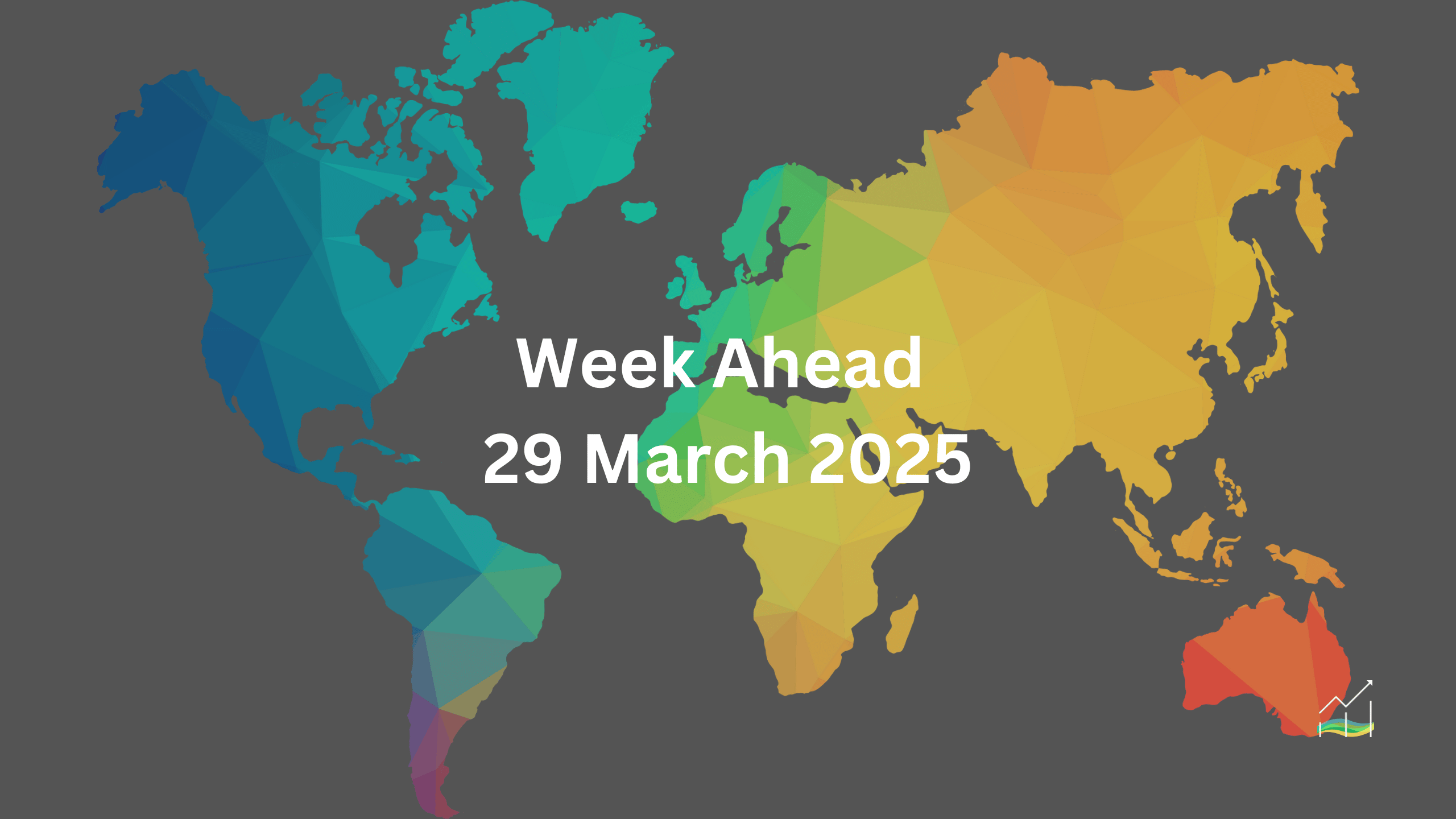29/03/2025 Week Ahead

New U.S. Policies Are Changing the Economic Landscape
Global markets face uncertainty as the U.S. prepares to introduce significant tariffs on April 2, raising investor concerns about economic growth and international trade dynamics.
In the U.S., the spotlight will be on employment data to assess if tariff uncertainty is beginning to impact the economy. Europe will closely watch eurozone inflation figures, influencing future European Central Bank policy. Meanwhile, Asia anticipates key economic reports, including Australia's interest rate decision, data from Japan, and manufacturing updates from China.
President Trump's tariff and foreign policies have sparked notable shifts globally. Germany is launching substantial infrastructure investments, and the European Union is moving towards more flexible fiscal policies. European nations are adjusting defense strategies amid strained relations with the U.S., highlighted by the recent diplomatic tensions within NATO.
Canada's political landscape is also evolving due to trade tensions with the U.S., pushing the country toward stronger ties with Europe. Trump's administration argues allies unfairly exploit U.S. trade, although economic data indicates that trade deficits largely result from strategic investments by U.S. companies abroad.
Recently, the U.S. dollar weakened as investors shifted funds away from American equities, influenced by falling U.S. bond yields and rising yields abroad, especially in Europe and Japan.
United States of America
Overview
Global markets face heightened volatility as the U.S. prepares to implement significant import tariffs on April 2, labeled as "Liberation Day" by President Trump. The new tariffs, aimed at reducing U.S. trade deficits, could strain international relations, affect economic growth, and pressure financial markets. Consumer confidence is already weakening amid uncertainty, potentially dampening economic activity while fueling inflation.
Economic Drivers
U.S. tariff policies are the central driver influencing market sentiment, with significant implications for economic growth and inflation. Investors fear that tariffs could reduce economic activity, pushing the Federal Reserve into renewed rate cuts despite rising inflation pressures.
- Broad-based tariffs targeting major trading partners could disrupt global supply chains.
- Potential job losses from tariffs and government layoffs may slow economic growth.
- Reduced tourism from Europe and Canada, driven by consumer boycotts against the U.S., may further worsen the U.S. trade deficit.
Data and Events
Upcoming U.S. economic reports will be crucial for assessing the real impact of tariff uncertainty on economic health.
- ISM Manufacturing Index (Tuesday): Expected to indicate weakening manufacturing activity.
- JOLTs Job Openings February (Tuesday): Provides insights into job market stability.
- ADP Private Payrolls March (Wednesday): Indicates private-sector employment trends.
- ISM Services Index (Thursday): Reflects the health of the broader service economy.
- Weekly Jobless Claims (Thursday): Monitors potential increase in unemployment filings.
- U.S. Non-Farm Payrolls Report (Friday): The most critical employment indicator, expected to show a slowdown with potential job growth below 100,000.
Price Action
Market sentiment remains fragile ahead of the tariff implementation date. Investors may experience increased volatility in equities, bonds, and currency markets, particularly the U.S. dollar, as traders react cautiously to shifting economic forecasts and uncertain policy impacts.
Key Points:
- U.S. tariffs effective April 2 could significantly disrupt global markets.
- Economic indicators this week will clarify tariffs’ impact on U.S. jobs and activity.
- Consumer confidence is declining; inflation pressures may complicate Fed actions.
- Technical volatility expected across equities, bonds, and currency markets.
Australia
Overview
The Reserve Bank of Australia (RBA) is expected to hold interest rates steady during its April policy meeting. However, growing economic uncertainties—including global trade tensions, domestic employment weakness, and the upcoming May elections—mean the central bank may consider cutting rates as early as its May meeting.
Economic Drivers
The Australian economy faces pressures from multiple factors, including global trade risks and domestic economic weakness. The RBA remains cautious, awaiting clearer signals from upcoming inflation data.
- Global trade tensions pose risks to Australia's commodity-driven economy.
- Recent employment data indicates weakness, with a notable decline of around 36,000 full-time jobs in February.
- Cyclone Alfred, which struck in early March, could negatively impact short-term growth, employment, and inflation.
Data and Events
Several important events and reports will influence Australia's economic outlook:
- RBA Interest Rate Decision (April 1-2): Expected to keep rates unchanged while signaling caution.
- First-Quarter Inflation Data (Late April): Key data that could trigger a rate cut in May.
- National Elections (May 3): Prime Minister Albanese seeks re-election; recent polls favor his incumbent Labor Party.
Price Action
The Australian dollar rose approximately 1% in March but remains vulnerable. Currently trading around the midpoint ($0.6200-$0.6400) of its recent range, it faces technical resistance near February's high of $0.6410. A downside break below $0.6200 could signal further declines toward the year's low near $0.6100.
Key Points:
- RBA likely to hold rates steady at April meeting but signal uncertainty.
- Weak employment and global trade risks increase chance of a future rate cut.
- Inflation data and May elections are crucial near-term influences.
- AUD faces technical vulnerability; watch for potential breaks below $0.6200.
Canada
Overview
Canada's economy enters a crucial period as new U.S. tariffs targeting Canadian goods, including autos, are set to take effect next week. Recent positive economic indicators could be overshadowed by these trade tensions, posing significant risks for growth. Additionally, Canada's political landscape is heating up, with an upcoming election adding to market uncertainty.
Economic Drivers
Canada’s economy remains vulnerable to escalating U.S. trade pressures and political uncertainty at home. While recent data indicates strong economic performance early in the year, the anticipated impact of new tariffs could sharply dampen growth prospects.
- Existing and upcoming tariffs on Canadian steel, aluminum, and autos threaten economic stability.
- Political tensions with the U.S. raise concerns over broader diplomatic and economic relationships.
- Upcoming national elections create uncertainty as the Liberal Party under Mark Carney adopts a more pro-business approach to counter trade threats.
Data and Events
Investors will closely watch key economic releases for insights into Canada's resilience amid tariff concerns:
- February Trade Balance (Thursday): Provides early signals of tariff impact.
- March Employment Data (Friday): Crucial indicator reflecting the real-time health of the economy under trade pressures.
- Bank of Canada Interest Rate Decision (April 16): Expected to maintain rates after March's cut, but remains critical to monitor.
Price Action
The Canadian dollar recently strengthened against the U.S. dollar for two consecutive months, following five months of prior weakness. However, upcoming tariffs place the Canadian dollar under renewed pressure. Despite this risk, the USD/CAD exchange rate currently remains below key resistance near 1.4300, suggesting potential vulnerability if tariff-related fears intensify.
Key Points:
- U.S. tariffs on Canadian goods pose significant economic risks.
- Political shifts and upcoming elections add market uncertainty.
- Crucial trade and employment data this week will provide clarity.
- Canadian dollar vulnerable amid renewed trade tensions; monitor closely around 1.4300.
China
Overview
Markets will closely monitor China's upcoming Purchasing Managers' Index (PMI) data to assess the strength of the country's economic recovery amid persistent trade tensions with the U.S. Recent reforms and stimulus measures have yet to fully stabilize growth and inflation, though investor confidence has risen due to advancements in technology and innovation.
Economic Drivers
China continues to navigate economic challenges despite stimulus and reforms aimed at boosting growth. Trade tensions remain a significant factor, although emerging technologies have provided some optimism.
- Persistent deflationary pressures and subdued growth despite government interventions.
- Escalating trade tensions with the U.S. continue to pose risks to the manufacturing sector.
- Technological advancements, including AI and rapid-charging EV technology, have attracted significant investor interest and driven market optimism.
Data and Events
The following data releases will be pivotal in gauging China's economic performance:
- Official Manufacturing PMI (March) – Monday: Indicates overall factory activity amid tariff pressures.
- Official Non-Manufacturing PMI (Services & Construction) – Monday: Provides insights into domestic economic recovery beyond manufacturing.
- Caixin Manufacturing PMI (Private Sector) – Tuesday: Offers a different perspective on industrial performance and export orders.
- Caixin Services PMI – Thursday: Highlights growth or weaknesses in China's consumer and services sectors.
Price Action
The Chinese yuan remained relatively stable against the U.S. dollar in early 2025, with authorities managing its exchange rate closely. In Q1, the USD/CNY traded within a narrow range of about 1.6%, reflecting China's cautious stance. The offshore yuan saw slightly more movement but remained contained through periodic interventions, signaling authorities' intent to maintain currency stability amid economic uncertainties.
Key Points:
- PMI data to clarify China's economic recovery strength amid ongoing trade tensions.
- Persistent economic challenges despite reform and stimulus measures.
- Technological advancements provide optimism and investor confidence.
- Chinese yuan remains stable due to careful government management.
Europe
Overview
Markets across Europe will closely watch inflation data this week, crucial for understanding the European Central Bank's (ECB) future interest rate decisions. With signs of economic recovery emerging and significant policy shifts in Germany and the EU aimed at infrastructure and defense spending, this could mark a pivotal moment for Europe's economic outlook.
Economic Drivers
European economies are experiencing cautious optimism, driven by recent policy changes and improving economic indicators. Germany's major infrastructure spending initiative and the EU's increased fiscal flexibility help reduce economic risks.
- Germany's €500 billion infrastructure plan signals increased government spending.
- EU fiscal rules easing, allowing greater investment flexibility.
- Improving economic sentiment indicated by recovering PMI readings above the key expansion level (50).
Data and Events
This week's economic reports will help gauge inflation trends and overall economic health:
- Italian and German Inflation (Flash Estimates) – Monday.
- Eurozone Inflation Report – Tuesday (critical for ECB policy decisions).
- Manufacturing PMIs (Italy, France, Germany, Eurozone) – Tuesday.
- Eurozone Unemployment Rate (February) – Tuesday.
- Services PMIs (Eurozone) – Thursday.
- Eurozone Producer Prices (February) – Thursday.
- German Manufacturing Orders, French & Italian Industrial Production – Friday.
- Government Bond Auctions: Germany (Tuesday & Wednesday), Spain and France (Thursday).
Price Action
European bond yields rose moderately in March, reflecting improved economic sentiment without causing significant concerns in weaker eurozone economies. The ECB recently cut its deposit rate to 2.75%, and markets expect another small rate cut soon, with expectations that rates will gradually approach the ECB's neutral level of around 1.75%.
Key Points:
- Eurozone inflation data this week critical for ECB rate policy.
- Increased government spending by Germany and EU reduces economic risks.
- Important economic data releases expected, including PMIs and unemployment.
- ECB likely to continue gradual rate cuts toward a neutral rate of approximately 1.75%.
Japan
Overview
Japan's economy faces growing uncertainty as corporate sentiment weakens, primarily driven by worries over potential U.S. tariffs, slower growth in China, and domestic inflation pressures. Upcoming economic data and corporate surveys will offer critical insights into Japan’s current economic situation and future policy direction.
Economic Drivers
Several factors are impacting Japan’s economic outlook, including external trade pressures, slowing domestic consumption, and persistent inflation above the central bank’s target.
- Rising U.S. tariffs and slower Chinese growth hurting manufacturing confidence.
- High inflation continues to squeeze domestic consumption and spending.
- Despite elevated inflation (3%), the Bank of Japan (BOJ) remains cautious, preferring gradual monetary tightening.
Data and Events
Key economic reports and auctions this week will clarify Japan’s economic trajectory:
- Industrial Production (February) – Monday: Expected rebound of 2.2% after January’s decline.
- Retail Sales (February) – Monday: Indicates consumer spending trends.
- Tankan Corporate Survey (Q1) – Tuesday: Likely to show declining sentiment among major manufacturers.
- New Car Sales (March) – Tuesday: Reflects consumer demand and economic confidence.
- Household Spending (February) – Friday: Provides insight into domestic economic strength.
- Government Bond Auctions – Monday (2-year notes, ¥2.6 trillion) and Thursday (10-year JGBs, ¥2.6 trillion): Investors may show increased interest at the start of Japan's new fiscal year.
Price Action
The yen strengthened significantly in early March as U.S.-Japan yield differentials narrowed, but has since retreated as this gap widened again. Currently, the dollar is expected to pull back toward the ¥148.50–¥149.00 range due to anticipated weakness in U.S. economic data. Market expectations for the BOJ's next rate hike have slightly increased, with a move most likely in October rather than earlier in the year.
Key Points:
- Japanese business sentiment under pressure from tariffs, inflation, and slower external demand.
- Crucial economic data this week includes Tankan survey, industrial production, and retail sales.
- Yen likely to strengthen modestly, targeting ¥148.50–¥149.00 amid expected softer U.S. data.
- BOJ remains cautious; markets see next rate hike most likely in October.
United Kingdom
Overview
The UK faces economic pressures from upcoming U.S. tariffs, especially targeting the automotive sector, alongside weaker domestic growth forecasts. The UK government has responded with tighter spending measures and efforts to address tax avoidance, but uncertainty remains high as markets anticipate potential interest rate cuts by the Bank of England (BoE).
Economic Drivers
The UK’s economic outlook has deteriorated amid trade tensions, rising borrowing costs, and lowered growth expectations. Fiscal policy adjustments reflect these challenges as the government seeks to manage economic risk.
- U.S. tariffs, particularly on autos, threaten approximately $12 billion of UK exports.
- Increased borrowing costs and slowing growth put fiscal targets at risk.
- Risks around reciprocal U.S. tariffs in response to the UK’s digital tax and VAT policies.
Data and Events
Key data releases and financial activities this week include:
- Mortgage Lending, Approvals & Consumer Credit (February) – Monday.
- Manufacturing PMI (Final March Reading) – Tuesday.
- Sale of Index-Linked Gilts (Sept 2035) – Wednesday.
- Services PMI (Final March Reading) – Thursday.
- Sale of Gilts (Jan 2040) – Thursday.
Price Action
Sterling has recently consolidated, trading in a tight range above $1.2850, occasionally testing the psychological $1.30 resistance. A decisive move outside this range ($1.2850–$1.3015) will likely determine the currency’s next short-term trend. Market expectations currently indicate about a 75% chance of a BoE rate cut in May, down from earlier expectations but still suggesting pressure on sterling.
Key Points:
- UK economy vulnerable to upcoming U.S. tariffs, particularly autos and digital taxes.
- Government fiscal strategy tightened amid growth forecast cuts and increased risks.
- Important economic reports this week on housing, manufacturing, and services sectors.
- GBP/USD consolidation points to a decisive breakout soon; watch $1.2850 and $1.3015 closely.
- Markets increasingly expect a BoE rate cut in the near term.
© 2025 SKONE Enterprise (003319453-V). All rights reserved.
The content on this site is for informational purposes only and does not constitute financial advice.


